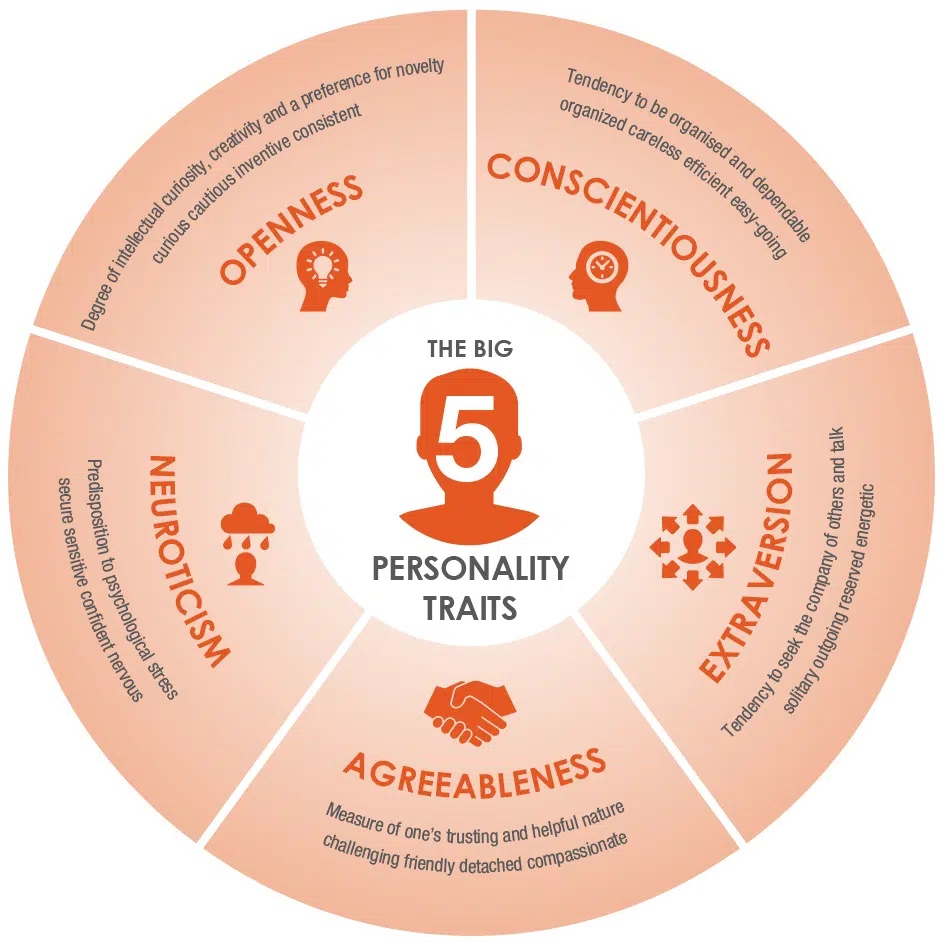Customer Psychographics: Different Personality Trait Models Explained

In this second blog post on customer psychographics, we will investigate the different models used to define psychographic traits and their advantages and limitations. These models vary from ancient ones like the four temperaments to modern ones like the Five Factor Model. We'll explore what they are and discuss their strengths and weaknesses. We are trying to provide a holistic view of the different models, even though most are not practical or are simply invalid.
Prefer watching and listening? Here you go!
Personality Trait Models
The Theory of Four Temperaments
The theory of four temperaments, dating back to ancient Greece, classifies individuals into four primary temperaments: Sanguine, Choleric, Melancholic, and Phlegmatic. Each temperament represents a distinct personality style, reflecting a person's general behavioral tendencies.
Sanguine Temperament: Sanguine people are cheerful extroverts. They're known for their optimism, enthusiasm, and sociability. They easily make friends and bring vitality and joy to social situations.
Choleric Temperament: Choleric individuals are assertive and goal-oriented. They can be competitive and may show intense bursts of anger when facing challenges. Their assertiveness can be a strength but may lead to conflicts.
Melancholic Temperament: Melancholic people are analytical and introspective. They pay close attention to details but may experience mood swings and sadness. They excel in roles that require analytical thinking but can sometimes dwell on negative thoughts.
Phlegmatic Temperament: Phlegmatic individuals are easygoing and calm. They handle stress well and maintain a sense of peace and contentment. They are good listeners and supportive in relationships, but their easygoing nature can lean toward complacency.
Restrictions and Problems
This model is limited in its scope as it oversimplifies the complexities of human personality, providing broad categories that may not fully capture the diversity of individual behavior. It lacks the depth and specificity required for precise marketing strategies.
Myers-Briggs Type Indicator (MBTI)
The Myers-Briggs Type Indicator categorizes individuals into one of 16 personality types based on four dichotomies: extraversion/introversion, sensing/intuition, thinking/feeling, and judging/perceiving. It is widely used in various settings, including workplaces and self-help contexts.
Restrictions and Problems
The reliability of the MBTI is questioned, as individuals often do not consistently identify with the type revealed by the test. The results can fluctuate over time, and the test has been criticized for poor validity and reliability. While the MBTI resembles some psychological theories, it is not widely endorsed by academic researchers in the psychology field and has been criticized as pseudoscience. Most of the research supporting its validity has been produced by organizations with potential conflicts of interest, raising concerns about independence and bias.
Factor Models of Personality
Backed by scientific research, the Sixteen Factor Model of Personality, the Seven Factor Model of Personality, the Six Factor Model of Personality, and the OCEAN Big 5 model stand out as critical players in personality research. Except the 16 Factor Model, they share a common foundation and build upon one another, with the OCEAN Big 5 model serving as a fundamental framework.
However, for practical purposes, the original OCEAN Big 5 remains the only viable model, while the others are often considered “overkill” by many marketers and customer experience experts.
Accordingly, we explain why the Five Factor Model is often the top choice for marketing and messaging. If you want to save time, jump directly to the Big Five section and skip those models of less relevance.
16-Factor Model of Personality
The 16 Factor Model of Personality, developed by Raymond Cattell, is a framework that provides a detailed understanding of a person's personality. It accomplishes this by uncovering and measuring 16 primary factors that shape an individual's unique character. These factors dive deep into various traits, peeling back the layers to capture the intricate nuances of how people behave and think.
These 16 factors include:
- Warmth: The level of friendliness and warmth displayed in interactions.
- Reasoning: The capacity for logical thinking and problem-solving.
- Emotional Stability: The degree to which an individual remains emotionally composed and stable in varying situations.
- Dominance: The inclination toward assertiveness and leadership qualities.
Liveliness: The presence of high energy levels and enthusiasm in one's approach to life. - Rule-Consciousness: The adherence to rules, regulations, and societal norms.
- Social Boldness: The willingness to take social risks and engage with others assertively.
Sensitivity: The responsiveness to emotional and social cues in one's environment. - Vigilance: The level of alertness and watchfulness in various situations.
- Abstractedness: The inclination toward abstract thinking and immersion in thought.
- Privateness: The desire for personal space and introspective reflection.
- Apprehension: The tendency to experience anxiety and apprehension in uncertain situations.
- Openness to Change: The receptivity to new experiences and willingness to embrace change.
- Self-Reliance: The degree to which an individual depends on their self for guidance and decision-making.
- Perfectionism: The pursuit of excellence and meticulous attention to detail.
- Tension: The experience of emotional tension and stress.
Restrictions and Problems
This model can be overly complex and challenging to apply in practical marketing scenarios. Analyzing 16 factors for each individual can be cumbersome, and not all 16 factors may be relevant to a specific marketing campaign.
Seven Factor Model of Personality
The Seven Factor Model of Personality, crafted by Auke Tellegen and Niels G. Waller in 1987, offers an expanded perspective on personality, building upon the foundation of the Big Five model. This model introduces seven distinct dimensions that provide a more nuanced understanding of human behavior and traits. Let's look at each dimension and how they contribute to a deeper insight into personality.
Positive Emotionality: This dimension examines how an individual experiences positive emotions such as happiness and joy. People high in positive emotionality tend to be optimistic, cheerful, and often radiate positivity. Their enthusiasm can significantly impact their consumer choices and interactions.
Negative Emotionality: In contrast, negative emotionality evaluates the likelihood of experiencing negative emotions, including anxiety, fear, sadness, and anger. Recognizing the degree of negative emotionality in consumers can guide marketers in addressing concerns, alleviating fears, and tailoring messages to mitigate negative emotions.
Dependability: Dependability measures the extent to which a person demonstrates reliability, responsibility, and organizational skills. Consumers with high dependability values may appreciate products and services that align with their need for consistency and reliability, making them a valuable segment for specific marketing campaigns.
Agreeability: Similar to agreeableness in the Big Five model, agreeability reflects a person's tendency to be cooperative, compassionate, and pleasant in their interactions. This dimension can be instrumental in designing customer-centric marketing strategies that resonate with individuals seeking harmonious and pleasant experiences.
Conventionality: Conventionality pertains to the level of adherence to social norms, traditions, and conventions. Understanding this dimension can help marketers create content and products that align with traditional values, customs, and societal norms, appealing to consumers who prioritize conventionality.
Positive Valence: Positive valence assesses the inclination to interpret situations and events in an optimistic and positive way. Marketers can leverage this insight to craft messages that evoke positivity and optimism, which can resonate with individuals who tend to perceive situations optimistically.
Negative Valence: Negative valence represents the inclination to view situations in a negative and pessimistic manner. Recognizing this dimension can assist marketers in addressing consumer concerns and crafting solutions that alleviate negativity, making it a valuable aspect to consider in customer-centric marketing approaches.
Restrictions and Problems
While it offers more detail than the Big Five, this model may still provide more information than needed for most marketing situations, making it better suited for in-depth psychological research rather than practical marketing campaigns.
Six Factor Model of Personality
The Six Factor Model of Personality distills personality traits into six core factors: sincerity, excitement, competence, sophistication, ruggedness, and glamour. These factors offer marketers a unique lens to understand consumers' distinct personality characteristics.
Restrictions and Problems
Like the Seven Factor Model, this approach may be too detailed for many marketing scenarios. It may not be the best choice for general marketing and messaging, as not all six factors may be relevant to a specific audience or campaign.
Five-Factor Model of Personality (Big Five)
The Five Factor Model, or Big Five, classifies personality into five core dimensions: Openness, Conscientiousness, Extraversion, Agreeableness, and Neuroticism.

Developed by several key researchers in the mid-20th century, including Lewis Goldberg and Warren Norman, this model has gained widespread acceptance due to extensive research validating its cross-cultural and demographic applicability. Decades of research by these and other notable scholars have proven the model's stability, robustness, and neurological and genetic underpinnings. Additionally, this model is well-suited for marketing and sales applications because of its simplicity, versatility, and extensive research support.
In the following section, we will closely examine the different traits and how they provide a better understanding of the customers and internally for Human Resources.
Openness to Experience is marked by imagination, curiosity, creativity, and tolerance for new ideas. These individuals thrive on diversity, art, and exploration, so communication should encourage intellectual exchange, flexibility, and fresh perspectives. They respond best to innovative, artistic, or socially conscious ads, and in the workplace, they bring adaptability, creativity, and a strong appetite for learning, thriving in dynamic environments that value change and inclusion.
Conscientious people are reliable, disciplined, and detail-oriented, with a strong sense of responsibility. Clear, structured, and professional communication resonates with them. They prefer ads that are informative, trustworthy, well-organized, and ethical, highlighting value and long-term benefits. In organizations, they provide dependability, strong planning and compliance, and leadership potential through their focus on excellence and accountability.
Extraverts are sociable, energetic, and assertive, thriving on interaction and stimulation. They prefer lively, engaging communication that offers collaboration and recognition. Ads that are bold, upbeat, humorous, interactive, or backed by influencers appeal to them. In the workplace, they shine in teamwork, networking, leadership, and customer-facing roles, bringing enthusiasm and positivity that energize teams and environments.
Agreeable individuals are empathetic, cooperative, and harmony-driven. Warm, supportive, and consensus-seeking communication works best with them. They value ads that are emotional, inspirational, inclusive, family- or community-oriented, and ethically grounded. In professional settings, they build strong relationships, resolve conflicts, support inclusive cultures, and often take on nurturing leadership roles.
Neuroticism reflects emotional sensitivity, self-criticism, and vulnerability to stress, but also empathy and emotional depth. Communication should provide reassurance, calmness, and constructive support. These individuals are drawn to ads that emphasize safety, security, well-being, and authenticity, especially those offering solutions and empathy. In organizations, they benefit from stress management resources, clear expectations, flexible environments, and strong mental health support, which help unlock their creativity and resilience.
